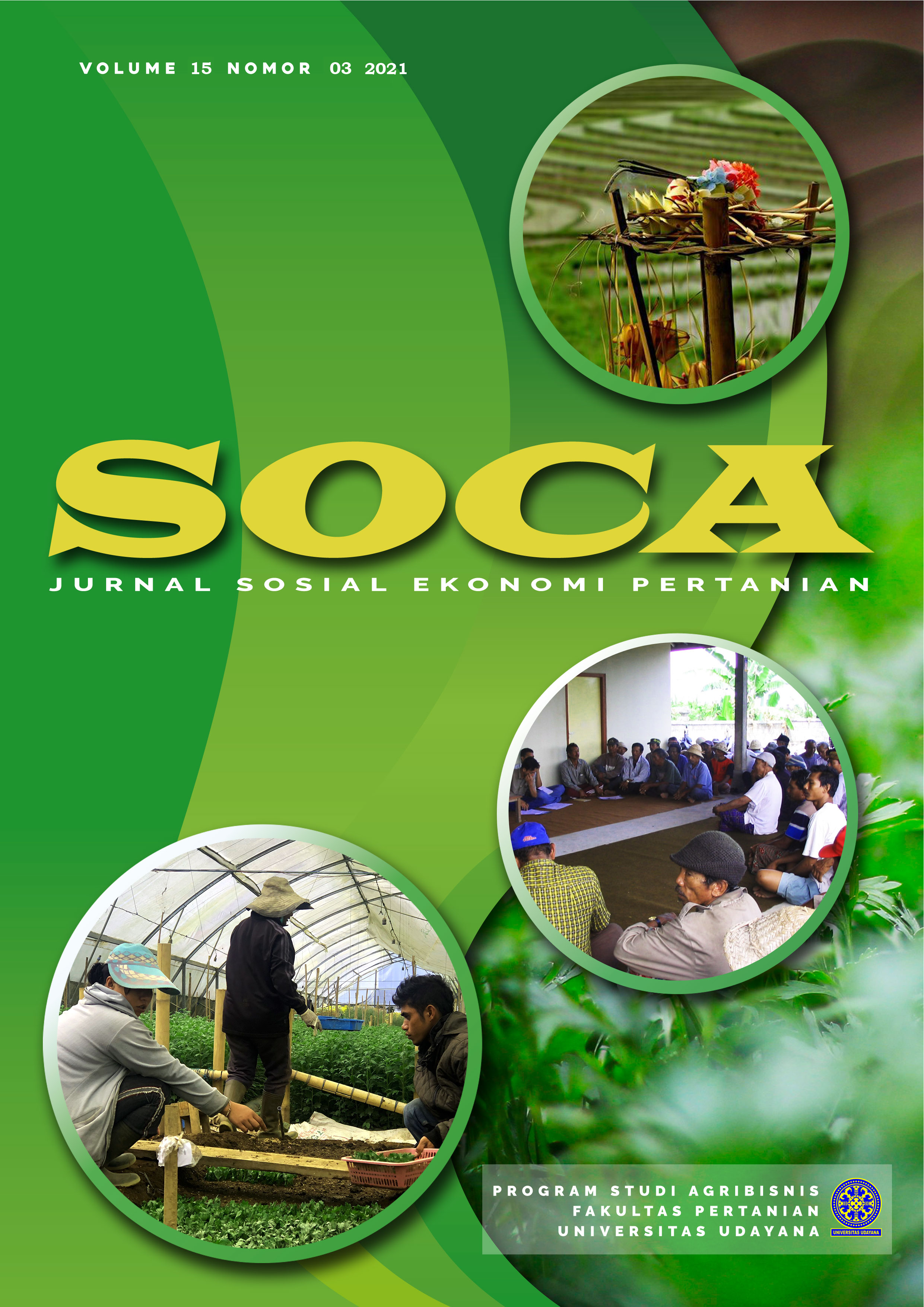The Existing Method to Assess the Disease Incidence of Bacteria Leaf Blight and Its Effect to Rice Yield to Support the Indonesian Agriculture Insurance
Abstract
Bacterial leaf blight (BLB) has become a major obstacle and a limiting factor in national rice production. Basically, this disease is caused by the bacterium Xanthomonas oryzae pv. oryzae. Therefore, to minimize the risk of disease infection to yield lost; The Ministry of Agriculture of the Republic of Indonesia has the agriculture insurance program. To support the program, the observations of disease incidence of the disease using existing method are needed. The purpose of this study was to determine the development of bacterial leaf blight on rice plants in Subak Munggu and to determine the effect of bacterial leaf blight on the yield of rice plants. Research activities included (1) isolation of pathogens from symptomatic leaves of rice plants, (2) weekly observations (3) morphological identification of pathogens (4) yields analysis. The results of this study showed the development of bacterial leaf blight in Subak Munggu, Munggu Village, Mengwi Sub-district, Badung Regency for ten weeks. The yield by calculating the weight of grains in each plot was calculated, it can be concluded that a sample that showed a high percentage of disease at the harvest time will cause the low grain yield production.
Downloads
References
Adinugroho. (2008). Konsep Timbulnya Penyakit. Retrieved from http://konsep-timbulnya-penyakit.pdf
BBPOPT Balai Besar Peramalan Organisme Pengganggu Tumbuhan. (2007). Efektivitas Bakteri Antagonis Corynebacterium terhadap HDB/KRESEK. http://www.bbpoptjatisari.com. Diakses pada tanggal 20 Oktober 2010.
Ditlin (Direktorat Perlindungan Tanaman Pangan). (2011). Laporan Tahunan 2010 Direktorat Perlindungan Tanaman Pangan. Dirjen Tanaman Pangan. Kementerian Pertanian, Jakarta.
Elings, A., Reddy, P. R., Marimuthu, T., Rossing, W. A. H., Jansen, M. J. W., & Teng, P. S. (1997). Rice bacterial leaf blight: Field experiments, system analysis and damage coefficients. Field Crops Research, 51, 113–131.
Goto. (1990). Bakteri Antagonis Phylloplane Padi Sebagai Penekan Pertumbuhan Xhantomonas campestris pv. Oryzae Penyebab Penyakit HDB. Skripsi. In Marsidah. 2002. Malang: Univeristas Brawijaya.
Goto M. (1964). Kresek and pele yellow leaf systemic symptoms of bacterial leaf blight of rice caused by Xanthomonas oryzae (Uyeda et Ishiyama) Dawson. PI. Dis. Rep.48 : 858-861.
Herdiana, N. (2010). Potensi serangan hama tanaman jati rakyat dan upaya pengendaliannya di Rumpin, Bogor. Jurnal Penelitian Hutan Tanaman [Internet], 7(4), 177–185. Retrieved from http://fordamof.org/files/7.4.2010_potensi_serangan.pdf.
Hifni, H. R., & Kardin, M. K. (1998). No Title. Hayati, 5(3), 66–72.
https://www.pertanian.go.id/home/?show=news&act=view&id=3668. Diakses pada tanggal 27 Februari 2021. (n.d.).
Husodo SY. (2004). Swasembada beras masih labil . (On line) http://www.kapan lagi.com/h/ 0000039194.html. Diakses tanggal 5 Januari 2007.
Jonit, N. Q., Low, Y. C., & G.H.Tan. (2016). Xanthomonas oryzae pv. oryzae, Biochemical Tests, Rice (Oryza sativa), Bacterial Leaf Blight (BLB) Disease, Sekinchan. Journal of Applied & Environmental Microbiology, 4(3), 63–69.
Mew, T. W., Cruz, V. and, & Rayes, R. . (1982). Interaction of Xanthomonas campestris oryzae and Resistance of Rice cultivar. Phytopathology, 72(7), 786–789.
Ministry of Agriculture of The Republic of Indonesia. (2018). Petunjuk Teknis Pengamatan dan Pelaporan Organisme Pengganggu Tumbuhan dan Dampak Perubahan Iklim (OPT-DPI).
Ministry of Agriculture of The Republic of Indonesia. (2019). Agricultural Insurance for the Protection of Farmers’ Business.
Ministry of Agriculture of The Republic of Indonesia. (2021). Rice Farming Business Insurance, Harvest Failure Solution. https://www.pertanian.go.id/home/?show=news&act=view&id=1609. Diakses pada tangal 27 Februari 2021.
OEPP/EPPO. (2007). Xanthomonas oryzae. Bulletin OEPP/EPPO 37, 543-553.
Ogawa. (1993). Methods and Strategy for Monitoring Rice Distribusition and Identification of Resistence Genes to BLB (Xanthomonas campestris pv. Oryzae). In Rice (pp. 27 : 71-80). JARQ.
Ou, S. (1985). Rice diseases (Ed ke-2). Kiew (GB): Commonwealth Mycological Institute.
Qi, Z., & Mew, T. W. (1989). Types of resistance in rice to bacterial blight. In Bacterial blight of rice (pp. 125–134). Manila Philippines: IRRI.
Reddy, A. P. K. (1989). Bacterial blight: crop loss assessment and disease management. In Bacterial of Blight Rice Proceedings of the International Workshop on Bacterial Blight of Rice (pp. 79–88). Philippines: IRRI.
Semangun, H. (2004). Penyakit-Penyakit Tanaman Pangan Penting di Indonesia. Yogyakarta: Gadjah Mada University Press.
Shen, Y., & Ronald, P. (2002). Molecular determinants of disease and resistance in interaction of Xanthomonas oryzae pv. oryzae and rice. J. Microbe and Infection, 4(13), 1361–1367.
Sudjana. (1996). Teknik Analisis Regresi dan Kolerasi. Bandung: Tarsito.
Suparyono, & Sudir. (1992). Perkembangan penyakit bakteri hawar daun pada stadia tumbuh yang berbeda dan pengaruhnya terhadap hasil padi. MediaPenelitian Sukamandi, 12, 6–9.
Suparyono, Sudir, & Suprihanto. (2004). Pathotype Profile of Xanthomoas campestris pv.oryzae,isolates from the rice ecosystem in Java. Indonesian Jurnal of Agricultural Science, 5(2), 63–69.
Wahyudi, A. T., Meliah, S., & Nawangsih, A. A. (2011). Xanthomonas oryzae pv. oryzae Bakteri Penyebab Hawar Daun Pada Padi: Isolasi, Karakterisasi, Dan Telaah Mutagenesis Dengan Transposon. Makara Sains, 15(1), 89–96.
World Weather Online. (2019). Mengwi weather. Diakses 6 juli 2019. https://www.worldweatheronline.com/mengwi-weatheraverages/indonesia-general/id.aspx.













